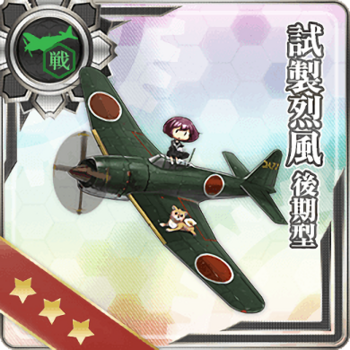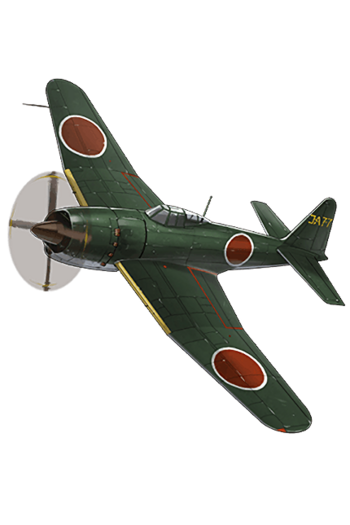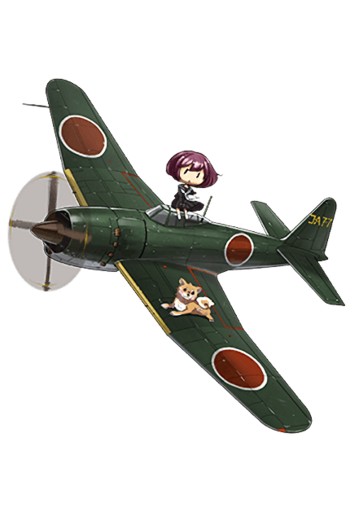- Welcome to the Kancolle Wiki!
- If you have any questions regarding site content, account registration, etc., please visit the KanColle Wiki Discord
Difference between revisions of "Prototype Reppuu Late Model"
m (Totaku moved page Reppuu to Prototype Reppuu Late Model) |
|||
| Line 1: | Line 1: | ||
| − | {{ | + | {{EquipmentInfo|22}} |
| − | | | ||
| − | |||
| − | |||
| − | |||
| − | |||
| − | |||
| − | |||
| − | |||
| − | |||
| − | |||
| − | |||
| − | |||
| − | |||
| − | |||
| − | |||
| − | |||
| − | |||
| − | |||
==Introduction== | ==Introduction== | ||
Revision as of 13:05, 8 March 2019
[Edit]
Prototype Strong Gale Late Model
No.22 試製烈風 後期型
| |
| Refittable Ship Types | |
| Fast Battleship | Battleship |
| Aviation Battleship | Standard Aircraft Carrier |
| Armored Carrier | Light Carrier |
| Heavy Cruiser | Aviation Cruiser |
| Light Cruiser | Torpedo Cruiser |
| Training Cruiser | Destroyer |
| Coastal Defense Ship | Submarine |
| Aircraft Carrying Submarine | Seaplane Tender |
| Fleet Oiler | Submarine Tender |
| Repair Ship | Amphibious Assault Ship |
| LBAS Plane | |
Introduction
名機「零戦」の後継機と開発された最新鋭艦上戦闘機「烈風」。
用兵側の発動機選定ミスや多忙な現場設計陣などの苦境を超えて、ついに完成した新型艦戦です。
ぜひ、「流星」艦爆と共に、次世代の機動部隊艦載機部隊を編成して、空を制してくださいね!
The name of the state-of-the-art machine that was developed to be the successor of the "Zero" carrier-based fighter, is "Reppū". Despite difficulties in engine selection, preoccupied design teams and factories, it was completed as the new type of ship-based fighter. Together with the new "Ryuusei" torpedo-bomber, please organize a next-generation air task-force to control the sky!
Notes
Buildable. Stock equipment of Taihou Kai and Jun'you Kai Ni.
Historical Information
The Mitsubishi A7M2 Reppū (Strong Gale, Allied reporting name "Sam") was a naval fighter plane developed as a successor to the infamous Type Zero carrier-based fighter.
The result of the 17-shi carrier-based fighter specifcation, the Zero's sucessor (then referred to as Navy Experimental Type 17 Type A) was expected to be able to climb to 6,000m in less than 6 minutes and then fly above that altitude at 639km/h, all while carrying two 20mm cannons and two 13mm machine guns and retaining the A6M3 Zero Model 32's impressive manueverability.
Engine selection was a primary problem - meeting the specifications required a 2,000hp powerplant, of which all available options - the Nakajima NK9 and the more powerful Mitsubishi MK9 - were still in development. With a larger engine capable of the required output, wing-loading became an issue - the Navy had requested no more than 150kg/m², which the MK9 was expected to fulfill. Due to MK9 production delays however, the Navy instructed Mitsubishi's design team to use the Nakajima NK9.
The Specification 17 carrier fighter's development was further delayed due to production facilities prioritizing production of the A6M-series fighters and Mitsubishi's G4M bomber as well as fixing issues with A6M variants and Mitsubishi's J2M Raiden. The A7M1 Reppū prototype finally flew in May 1944, demonstrating excellent handling and manueverability but could not attain its lofty 640km/h target due to the underpowered NK9 engine. The Navy ordered development stopped due to the failure, but Mitsubishi obtained permission to test the aircraft with the MK9 engine.
The A7M2 prototype flew in October 1944, achieving a top speed of 628km/h while surpassing the Zero in many performance metrics, leading the Navy to officially adopt the type. Saburo Sakai declared it the finest fighter he had ever seen, while engineers claimed it could fight at altitudes up to 12km.
The A7M2 Reppū was expected to replace the A6M Zero as the standard fighter of Japanese air-forces, but production was disrupted due to earthquakes, Allied bombing raids and the loss of schematics and manufacturing jigs. The A7M Reppū subsequently never flew in combat.
The A7M3-J Reppū-kai was proposed as an interceptor with an increased maximum speed of 648km/h using a forced-induction version of the Mitsubishi MK9 and an armament consisting of six 30mm cannons. A working prototype was never produced.



